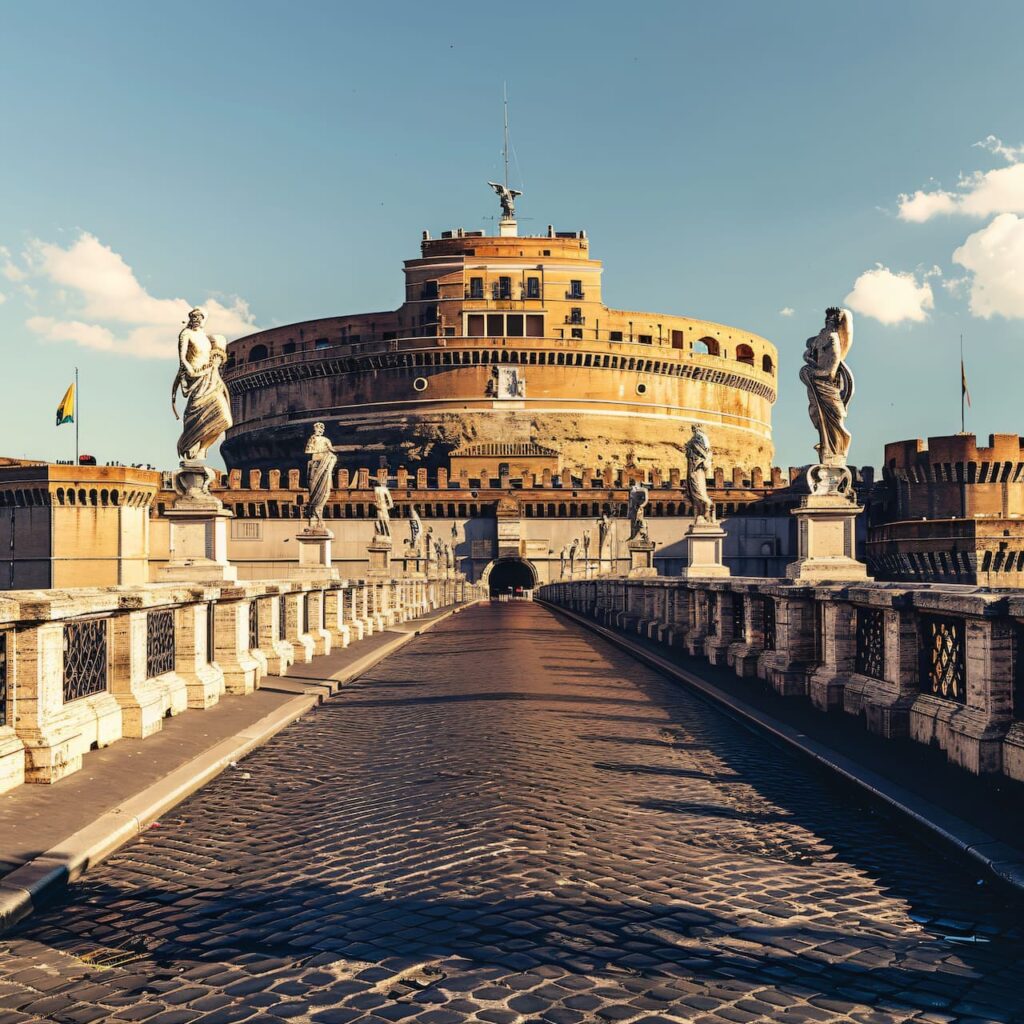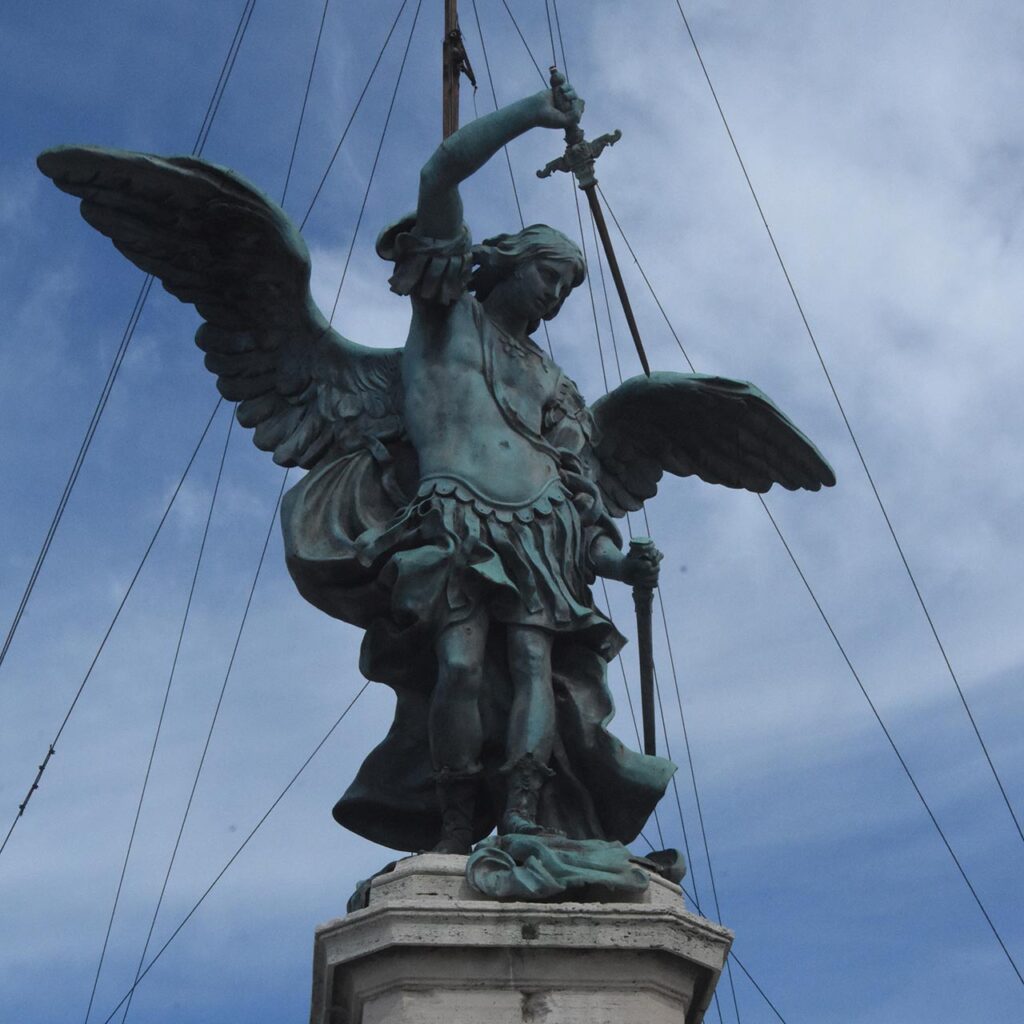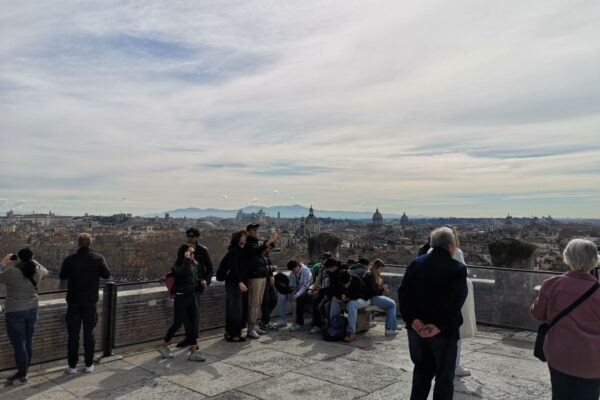The Statue of Castel Sant’Angelo has always been the object of curiosity on the part of enthusiasts all over the planet. If you are here, chances are you are among them. Rejoice, because you are in just the right place!
In this in-depth article, I will tell you the history of the Angel of Castello, starting from the legend of its appearance and going through all the steps that led this sculpture to be one of the most beautiful and densely packed significance in all of Rome;
As always, alongside the stories and legends, I will certainly not fail to mention a few amusing or bizarre anecdotes about the famous Statue of the Angel that towers on top of the Castle.
So, are you ready? Let’s get started!
IMPORTANT! Before starting this article, I want to warn you: Castel Sant’Angelo is one of the most visited tourist attractions in Italy and the world. With a year-round tourist season, it is almost certain that when you want to visit it, you will find a long queue at the ticket office. To avoid this, we recommend you buy your ticket online. Click below to book your entry and access Castel Sant’Angelo in an instant.

Castel Sant’Angelo Rome Tickets: Quick Access
Buy online. Choose your preferred time. Visit Rome’s Castel Sant’Angelo, Hadrian’s Tomb, the papal quarters, the fortress and much more.
You can cancel free of charge up to the day before the visit.
Castel Sant’Angelo Statue: Significance
Contents [show]
The colossal sculpture that still stands today at the top of Castel Sant’Angelo bears on its shoulders a long and rich history;
If you happened to be walking along the banks of the Tiber in the vicinity of the Castle, it is impossible that it did not catch your attention as well. I speak, of course, of the famous Statue of the Archangel Michael, located on the current Terrazza dell’Angelo;
But the bronze work, created by the sculptor Peter Anton von Verschaffelt and inaugurated in June 1752, is only the latest in a long series of depictions of a legendary event. The same one that lies behind the change of name of the Castle and the Bridge: the appearance of the Archangel Michael in Rome.
Want to know more about this formidable legend? Follow me in this exciting story!
Archangel Michael Statue Castel Sant’Angelo: History

Statue of Archangel Michael destroyed by fire
It all begins in 590 A.D., Pope Gregory the Great having just taken over from Pelagius II, who had been crushed by the pestilence that had come to Rome from Egypt;
The lues inguinaria, the epidemic plague that took the pontiff’s life, snakes through the streets of Rome and the Vatican, reaping endless victims. Gregory the Great, in an attempt to defeat the curse, summoned a procession in seven processions.
The litania is attended by all orders of the clergy, as well as the entire population. The corteo passes through the cities carrying the icon of MarySalus populi Romani. It is directed to St. Peter. Of what happens we have two important testimonies: that of Gregory of Tours, in the Historiae Francorum, and that of Jacopo da Varagine, in the Legenda Aurea;
During the procession, eighty people lost their lives in a single hour. The pope, leading the procession, urges the faithful to continue. At the Ponte Elio, in front of the Castellum Crescentii, the miracle takes place.
Schools of angels descend from heaven singing the antiphon of the Regina Coeli. They glide over the faithful, pass over their heads and surround the painting of Mary;
Gregorio then looked up and on the top of the castle noticed the immense figure of an angel.
No doubt, it is the Archangel Michael resheathing his sword after cleansing it of blood. The evil has been defeated: the plague, shortly afterwards, cesses to plague the Eternal City.
In memory of the event, the Castle changes its name, as does the bridge connecting it to the other side of the Tiber. A chapel named after the Angel is built on top of the Castel Sant’Angelo;
Towards the end of the 11th century, the chapel was replaced by a statue of St Michael made of wood.
A second one in marble follows, destroyed during a riot in 1379. The third, also made of marble but with bronze wings, shattered when lightning struck the castle and blew up a gunpowder store.
In 1497 a bronze statue was opted for, but in 1527 the need for warfare dictated that it be fused to make cannons. During the same century, Raffaello da Montelupo made another marble version with bronze wings, which was later replaced by the current bronze in 1752. It was made by the Flemish sculptor Peter Anton von Verschaffelt, and this too is a story worth telling.

It is 1746 and the pontiff, Pope Benedict XIV Lambertini, thinking of the approaching Jubilee of 1750, decides to endow Castel Sant’Angelo with a new statue of the Angel. In order to determine who will make it, he held a competition;
The winner is Peter Anton von Verschaffelt. Trained in Paris in the workshop of the sculptor Edmé Bouchardon, the Flemishman was already known in Rome as the pope’s portraitist. The sculptor immediately received payment for the plaster model;
For the creation of the provisional wooden model, Antonio Bicchierai produced a life-size painting on cardboard. Once the design was approved, the realisation of the travertine foundation was entrusted to the architect Nicola Michetti;
Instead, Francesco Giardoni did the founding work. He devoted himself to it, starting in 1750, in the workshop of the Belvedere in the Vatican;
The statue is finally made by assembling thirty-five pieces, to which the iron sword is added. It is a colossal sculpture that depicts the Arcangel in the act of sheathing his weapon: a snapshot of the vision that Pope Gregory the Great had over a thousand years earlier. He wears a armour with a windswept skirt, and rests his feet on clouds;
The inauguration did not take place on top of the castle until the end of June of 1752 and was presided over by the pontiff himself. But the sculptor would not see the work until a year later, having left Rome for London.

Castel Sant’Angelo Rome Tickets: Quick Access
Buy online. Choose your preferred time. Visit Rome’s Castel Sant’Angelo, Hadrian’s Tomb, the papal quarters, the fortress and much more.
You can cancel free of charge up to the day before the visit.
The Other Statues of Castel Sant’Angelo
Although the Statue of the Archangel Michael is the most impressive, and probably the most famous, it is certainly not the only sculpture we can admire near the Castel Sant’Angelo and the Bridge of Angels.
Below I will point out other equally noteworthy ones:
Saint Michael Archangel by Raffaello da Montelupo
That is, the statue that was replaced, in 1752, by the present one in bronze;
Made in the mid XVI century, among the many sculptures placed on the top of Castel Sant’Angelo this is the only one that has survived to the present day;
It is attributed to the sculptor and architect Raffaello da Montelupo, or Raffaele Sinibaldi;
The Arcangel Michael, made of marble, is depicted in a long robe. The armour is supported by shoulders showing the Farnese Lily;
The size of the head, which is out of proportion compared to the rest of the body, is justified by the original location, which envisaged a bottom-up view;
The wings, made of metal originally gold-plated, are perforated to decrease wind friction force;
The statue will be restored by a young Gian Lorenzo Bernini;
Once replaced, the sculpture was first transported to a niche in the Stairway of Paul III, and then to its current location, i.e. the court that took its name in 1910.
San Michele Arcangelo di Bracci Pietro
Less famous than the previous ones is the carved wooden statue made by the Roman Pietro Bracci;
Dressed as an ancient Roman warrior, complete with feathered helmet, Bracci’s St. Michael appears as a work that is not entirely finished. Posteriorly it is in fact only embellished, except for the helmet and hair;
This model, for a long time, was considered to be Berniniian, and thought of as a potential replacement for the one that already towered over the castle, or as a late 17th-century work. It was even classified in the inventory as a school work by Bernini;
Clarifying the misunderstanding will be art historian Elisabeth Kieven: thanks to documentary evidence, she identifies it with the Angelo carved for the Cappella del Maschio del Castello. This Renaissance chapel, built under Leo X, underwent modernisation works at the behest of Clemente XII in the first half of the XVIII century, including a marble niche to house the gilded statue of Bracci.
Statue of St. Catherine of Siena
Located in Largo Giovanni XXIII, and created here in 1962 on the initiative of the National Committee for the Celebrations of Catherine, the white marble statue is the work of sculptor Francesco Messina;
The Saint is depicted in movement, wrapped in a long mantle, in the act of bending over in a work of charity;
The monument is accompanied by four bas-reliefs depicting scenes from the life of the Saint;
Christian mystic, proclaimed by Pope Pius XII patron saint of Italy in 1939, St. Catherine was also the one who brought the pope back from Avignon to Rome;
Here she is remembered in the shade of two trees in the garden of Castel Sant’Angelo.
Statues on the Bridge of Angels
Statues on the Bridge of Angels
On the Ponte Sant’Angelo there are no less than twelve wonderful statues;
Below I will give you a list of their names, but if you want to learn more about them, I recommend reading my article on Ponte Sant’Angelo:
- Statue of St. Peter by Lorenzo di Lodovico di Guglielmo (Lorenzetto)
- Statue of St Paul by Paolo Taccone
- Angel with column by Antonio Raggi
- Angel with the Scourge of Lazzaro Morelli
- Angel with the Crown of Thorns by Paolo Naldini and Gian Lorenzo Bernini
- Angel with a Veil by Cosimo Fancelli
- Angel with a Tunic and Dice by Paolo Naldini
- Angel with Nails by Girolamo Lucenti
- Angel with the Cross of Ercole Ferrata
- Angel with the cartouche of Giulio Cartari
- Angel with sponge by Antonio Giorgetti
- Angel with a Lance by Domenico Guidi
Castel Sant’Angelo statues: Curiosities
Another statue, very recent, could be admired on the Ponte degli Angeli in Castel Sant’Angelo;
It is the profugee by contemporary artist Jago, stage name Jacopo Cardillo;
In flagella paratus sum, this is the name of the black marble work that depicts a young refugee lying on his side on a journey of hope. ‘I am ready for the scourge’. Interestingly, the name of the work coincides with the inscription at the base of the statue of the Angel with the Scourge, placed on the Bridge of Angels back in the XVII century!
After travelling for a month on board the Ocean Viking ship, Jago’s work had landed at the Olympic Stadium. It had then been transported to the Bridge of Angels in early August of 2022 for a temporary exhibition before its sale at auction for charity;
Unfortunately, just two months later, the anti-racism work was so damaged by vandals that it had to be removed.
Statue of St. Michael Archangel Mount Sant’Angelo: FAQ
The statue on Castel Sant’Angelo depicts the Arcangel Michael in the act of sheathing his sword. This was in fact the vision that Pope Gregory the Great had in 590 AD and which heralded the end of the plague.
The end of the plague that plagued Rome.
The statue above Castel Sant’Angelo is the statue of St. Michael the Archangel, made entirely of bronze by Peter Anton von Verschaffelt and inaugurated in 1752 by Pope Benedict XIV Lambertini.
The angel of Castel Sant’Angelo is the Arcangel Michael, also called St. Michael the Archangel.
Michele, adversary of Satan, is considered in popular tradition to be the defender of God and of the people, and the victor in the battle of good against evil. In the Orient he is revered as the prince of the celestial militias. In the vision that Pope Gregory the Great had of his appearance on the Castellum Crescentii, the Arcangel had just defeated the evil one and sheathed his sword after having freed the city from the plague. On 29 September 1949, Pope Pope XII proclaimed him patron of the State Police.
Castel Sant’Angelo Statue: Conclusions
This brings us to the end of this in-depth study of the Archangel Michael statue in Castel Sant’Angelo and the other important sculptures that can still be admired today.
I have clarified the meaning of this colossal work through the history of the sculpture and the legend from which it originated.
We talked about the other statues of the Angel, as well as the sculptures of St. Catherine and the many statues on the Bridge of Angels.
I have told you some more recent curiosities and answered the most frequently asked questions.
If you need more information, leave a comment below; if you would like to visit the Castle, buy your entry ticket and skip the queue at the ticket office.

Castel Sant’Angelo Rome Tickets: Quick Access
Buy online. Choose your preferred time. Visit Rome’s Castel Sant’Angelo, Hadrian’s Tomb, the papal quarters, the fortress and much more.
You can cancel free of charge up to the day before the visit.
Credits: photo by Weekend Wayfarers via Flickr


